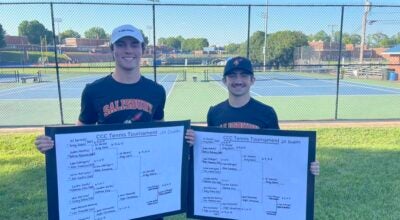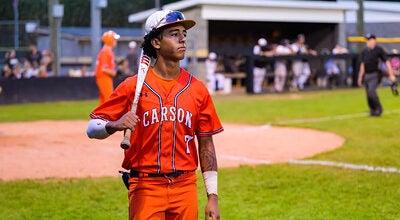SEC football remains strong
Published 12:00 am Thursday, January 5, 2012
By Paul Newberry
Associated Press
NEW ORLEANS — A few months ago, when there were rumblings that Virginia Tech might be jumping to the Southeastern Conference, Eddie Whitley and his teammates got excited.
“Everyone was like, ‘Man, I would love to play there!’” the Hokies senior safety said, his eyes lighting up. “I was like, ‘Man, I wish I was a freshman now!’”
The switch never happened. Virginia Tech stayed put, at least for the time being, in the Atlantic Coast Conference. But Whitley’s account sums up what just about everyone else in the nation has been forced to concede: Love it or hate, no one plays college football like the SEC.
Look no further than Monday night’s BCS title game between No. 1 LSU and No. 2 Alabama. For the first time under this format, two teams from the same league — heck, the same division — are facing off in a no-lose situation for the SEC. Before one strand of confetti falls to Superdome floor, the conference is assured of its sixth straight national title. No other conference has won more than three in a row.
“You’ve got the best athletes in the nation going to one conference,” Whitley marveled. “Alabama’s got linebackers that are 260, 270 (pounds). Our defensive TACKLES are 270.”
The SEC’s dominance has been decades in the making.
Many point to the SEC’s revolutionary decision in the early 1990s to expand from 10 to 12 teams, allowing it to become the first conference to split into divisions and set up its own championship game. Other factors, everything from an exclusive national television deal with CBS to top coaches such as LSU’s Les Miles and Alabama’s Nick Saban to the abundance of high school talent in the Deep South, help keep the SEC on top year after year.
But the real roots of the SEC’s breakaway can be traced to the turbulent ‘60s, when the region was ripped apart by the struggle for civil rights and its universities were still clinging to the notion of only letting whites through the schoolhouse door.
In 1966, Alabama posted a perfect 11-0 record with an all-white team but still finished third in The Associated Press poll behind Notre Dame and Michigan State, which had played to a 10-10 tie. The feeling at the time, and one that is even more apparent with the hindsight of history, was that both the Fighting Irish and the Spartans were superior programs because they had African-Americans players and faced teams that allowed them on the field, too.
“There were athletes who were qualified and capable and had the ability to play in the SEC, but they were not recruited because they were black,” said Wilbur Hackett, a longtime conference referee who, in the late ‘60s, became the first African-American captain when he played at Kentucky, persevering through intense racial prejudice.
When it became clear that integration was inevitable, the SEC finally tapped into a whole new pool of talent, gaining the inside track to huge numbers of immensely qualified locals who had always been forced to sign with historically black schools or venture far from home, to the Big Ten or the Pacific Coast, if they wanted to play at the highest level.
Today, every SEC roster is filled with black players. Their influence on the game is undeniable.
“The league was strong, but it could have been stronger if they had integrated sooner,” Hackett said. “Look at the Tennessee States and the Jackson States and the Gramblings, all the players from those schools that went on to play in the NFL. Now, those schools don’t put players in the NFL because all those players are in the SEC.”
Over the last 10 years, a staggering 72 players from SEC schools have been first-round draft picks. The Big 12 is next on the list, far behind at 51.
With Heisman Trophy winner Cam Newton leading the way, the SEC had five of the top six picks in 2011. The odd man out was Von Miller from Texas A&M — which is joining the league next fall.
“There’s a lot of talent down there and they do a good job of coaching a lot of talent,” said Al Borges, the offensive coordinator at Michigan who formerly coached at Auburn. “That’s all there is to it.”
Digging a little deeper, the emphasis on defense in the SEC has largely fueled its rise to power (34 of those 72 first-round picks came from the less-heralded side of the line). Not surprisingly, Alabama and LSU are the nation’s two best defensive teams, filled with impact players such as Crimson Tide linebacker Dont’a Hightower and Tigers cornerback Tyrann “Honey Badger” Mathieu.
From the perspective of ESPN analyst Todd Blackledge, it all starts up front.
“I really don’t think they have more speed at those skill positions on offense than the Big 12 or the Pac-12 or anyone else,” he said. “But those defensive linemen in the SEC, that’s where the difference is.”
Blackledge points to last year’s BCS title game, when Auburn stifled high-powered Oregon 22-19 to claim the SEC’s fifth straight championship. Offense may excite the fans, but teams such as West Virginia (a 70-33 winner over Clemson in the Orange Bowl) and Oklahoma State (which beat Stanford 41-38 in the Fiesta Bowl) didn’t qualify for the biggest game of all.
Rest assured, defense still wins championships.
“Auburn was, at best, a middle-of-the-pack defense in the SEC — and Oregon could not block their front,” Blackledge said. “Until teams in other conferences make inroads on defense, it’s just going to be hard to catch the SEC.”
Blackledge also believes that SEC schools are more willing to bring in junior college signees, especially on the defensive side, players who are often challenged academically and shunned by schools that don’t think they can keep up in the classroom.
This, of course, fits in with another popularly held image of the SEC as nothing more than a dozen football factories (well, 11, leaving out Vanderbilt). The largest building on most campuses is a palace such as Alabama’s Bryant-Denny Stadium (capacity: 101,821), a convenient symbol of college athletics gone wild. When Texas A&M joins, the conference will have eight of the 20 biggest stadiums in college football, all with seating for at least 80,000.
Of course, the SEC can quickly counter that it’s hardly the only conference to place a huge emphasis on football. Three of the four largest stadiums — at Michigan, Penn State and Ohio State — are in the Big Ten. And while plenty of SEC programs have run afoul of NCAA rules, perhaps the worst scandal in college football history erupted beyond its borders: the child-sex abuse accusations against former Penn State defensive coordinator Jerry Sandusky that led to the firing of coach Joe Paterno.
But there’s little doubt the SEC is boosted by an accident of geography, too. Five of the nine states in the league’s current makeup have no major-league franchises of any type to steal away attention from the gridiron.
“Maybe it’s the culture of the South,” said Michigan lineman David Molk, whose team was in New Orleans for the Sugar Bowl. “They’re much more focused on football. The North has a lot of other things to do. … Down here, it’s football. That’s it. It’s football from birth.”
Of course, there are those who’ve grown weary of all the SEC hype, who see it as a league that is reluctant to travel too far from home, yet still receives preferential treatment in the rankings and a little-too-much praise from the media.
Georgia, for instance, went 42 seasons without playing a regular-season game outside the confines of the old Confederacy (if Kentucky is included) before traveling to Oklahoma State in 2008. This season, Alabama lost to LSU at home, 9-6 in overtime, but still wound up No. 2 in the BCS rankings over other one-loss teams such as Oklahoma State.
“I do feel like they get first dibs on everything,” said quarterback Tajh Boyd of ACC champion Clemson.
Certainly, the folks at Big 12 champion Oklahoma State felt they deserved a chance to play for the title rather than having to watch an SEC rematch on TV.
“People see the SEC different than they do any other conference,” Cowboys coach Mike Gundy said. “It’s deservingly so, because they have won in the big game. But, in my opinion, from top to bottom the Big 12 was the strongest league in the country this year.”
Gundy, it seems, is in the minority.
“You could say we’re getting tired of hearing about the SEC, but we all know it’s the best,” Molk said. “They have all the talent. They should win it every year.”
———
AP Sports Writers Steven Wine in Miami and Jeff Latzke in Stillwater, Okla., contributed to this report.
———
Follow Paul Newberry on Twitter at www.twitter.com/pnewberry1963
The Associated Press
01/05/12 17:08





